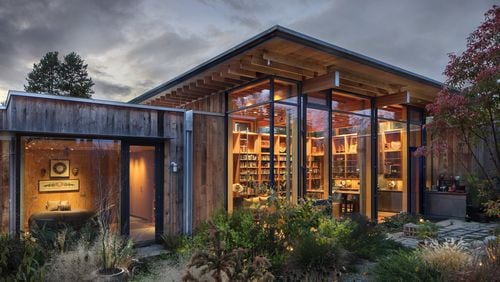KEY PENINSULA, Wash. — You can see how an architect and a homeowner might form a genuine friendship as they formulate a design: It’s an intensely intricate process that requires bare-your-soul discussions, high-stakes give-and-take, and a whole lot of together time.
In that respect, (architect) Jim Olson and (homeowner) Melissa worked a bit backward in creating her forward-looking home. They’ve been friends-that-feel-like-family most of their lives, thanks to common experiences, influences — and even dwellings — in one peaceful, meaningful Key Peninsula burg.
“I’ve known Melissa since sometime in the 1960s, when her parents moved from California to Longbranch,” says design principal Olson, of Olson Kundig. “Her father was an architect, and he did a very nice kind of rectangular, modern, midcentury-looking house. Melissa and I kind of shared this history of community where modern architecture was highly regarded and part of our early lives.”
Inspired by noted Northwest architect Paul Kirk, who had designed Olson’s aunt’s Longbranch home, Olson built his own cabin on his family’s property when he was 18 (“I’ve been adding on to it for 58 years now,” he says). At one point, there were three Olson homes in a row. Eventually, Melissa’s mother ended up buying Olson’s parents’ home — and then, Melissa inherited it.
“Now Melissa lives in a house (there) that my parents built about 1960,” Olson says. “She lives between my aunt’s house, which is just a treasure, and on the other side is my cabin, which she really likes. By being neighbors out in this rural area, we see a lot of each other on weekends. We each have a Labradoodle, and my wife and Melissa and I are kind of a threesome; we go for walks and are very close friends.”
Melissa also had a condo in the big city. “Two or three years ago, I started to fantasize about getting out of it,” she says. “I thought, ‘Wouldn’t it be fun if I could afford something Jim Olson did? Oh, that’s ridiculous.’ “
Except it really wasn’t.
“We’d sit down in his yard with our two dogs and fantasize,” she says. “We started talking. Sure enough, it was becoming an idea. I’d say, ‘You can’t bill me for this.’ “
We can’t speak to a possible friends-like-family discount, but Melissa’s glorious new urban retreat in Seattle — Olson calls it “City Cabin” — certainly benefited from interpersonal inspiration.
“Melissa wanted a house in town that felt like she was still at Longbranch; the whole idea was to create a feeling that you were still out in nature,” Olson says. “Melissa likes a lot of the things I did in my cabin. She’d come over every morning and say, ‘Could I look at your bathroom? I want it just like this.’ We’d go through my house: ‘How high is this ceiling? How wide is this room?’ Then to Aunt Peg’s house and see, ‘How big is this room? How high is this ceiling?’ The house really got designed by standing in other houses that were used as prototypes for it.”
In-depth insight contributed, too:
— Melissa knew: “Jim was always influenced by that Paul Kirk house in Longbranch; it was very light.”
It just so happened Melissa envisioned sun-worshipping clerestories and “oodles of big, open windows” for herself, along with a nothing-fancy-please “common area where we can all gather, with two separate bedrooms,” and a private connection to nature — all on an ordinary city lot. So Olson maximized the anything-but-ordinary home’s 2,400 square feet, working to “get as much as you can out of as little space,” he says. Its fabulous, functional design organizes around a brilliantly bright, high-ceilinged great room, with two extending wings (one the master suite, and the other a guest room and storage) and soothing garden views from every single room.
— Melissa told her architect friend: “I know you like concrete, but I don’t want that gray concrete; I want it warm.”
In response, Olson says, “I said, ‘Let’s go down on the beach (at Longbranch) and find a rock that’s the right color.’ You always think of the rocks on Puget Sound beaches as gray, but one by one, they’re yellow, white, black — a number of them are very beautiful terra-cotta-red. She found one exactly the color; we used it as our example.” And now, the allover concrete floors are tinted that precise Longbranch-beach-rock shade of red, which took Dovetail General Contractors four or five pours to match.
— And then Melissa told him: “Wouldn’t it be fun to have a net-zero house? We should try to do that.”
Olson knew there was even more to it.
“She’s always been a really avid environmentalist, funding a lot of preservation of land so it won’t be developed or logged off,” he says. “She also collects Native American art — their philosophy was always sustainability, so that philosophy and Melissa’s dedication to it seemed to point to a house that really represented her values.”
The goal, then: a home that’s as sustainable as possible (net-zero guidelines, but not official certification) — and as Melissa as possible.
So in addition to a background palette of raw wood and warm white walls and ceilings, Olson devised shelving to add order to Melissa’s vast art collection (“a huge variety of shapes and forms in regular little cubicles that help hold it together”), and project manager/project architect Renee Boone used a sliding, framed family-treasure rug to camouflage the big TV in the great room.
Sustainability-wise, Melissa’s home has an air-to-water heat pump; reclaimed, unfinished exterior fir siding (with natural, unstained plywood inside); extra-efficient insulation; low-energy appliances and LED lighting; giant triple-pane windows from Germany; a green roof; and photovoltaic panels — but those are not totally camouflaged by a metal shield along the edge, which Olson had suggested. “She said, ‘No! I want people to see them!’” he says.
“The spirit of this house is half me, half the client, and that’s what’s so much fun,” Olson says. “In this house, it’s like me interpreting Melissa.”
About the Author






